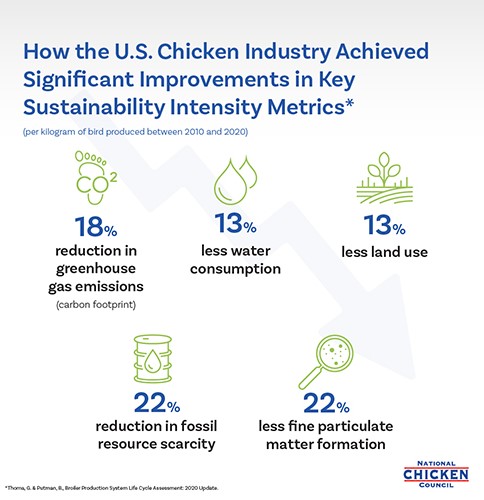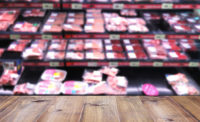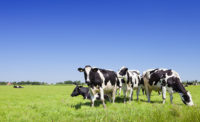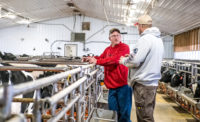When I wrote this column last year, I had certainly hoped the difficult situation brought on to all of us from the COVID-19 pandemic would be long behind us. As we all know, we’re not quite there yet.
By Mike Brown
President, National Chicken Council
Sponsored by:

I have been constantly impressed by and grateful for the toughness and the creativity of our industry when responding to change – both the long-view solutions that are best implemented slowly and the rapid deployments demanded by immediate need. We have shown ingenuity and commitment in the face of change, regardless of the challenge.
The COVID-19 outbreak reminded us that our food system has long been “critical” and “essential” before those words became part of our daily pandemic vocabulary. Our top priorities during the pandemic have been two-fold: keeping our essential workers safe, and keeping chicken stocked in the meat case. Chicken producers and their industry allies went above and beyond to ensure America’s #1 protein continued flowing to store shelves. In this, it was imperative that a proper balance was struck between ensuring a steady supply of food while maintaining the health and welfare of the people who work tirelessly to produce and deliver that food.
2021 Challenges
One of the headwinds to stepped-up pounds was and is the significant decline in hatchability. A combination of stressed breeder hens from the fallout of the highly usually winter storm in Texas and certain surrounding states is being compounded by the somewhat unexpected performance shortfall with a leading male breeder.
Also adding to the headwinds are higher feed costs that undoubtedly will continue through the 2021/22 crop year and beyond. In-plant labor shortages are being addressed with a boost in wages and benefits coupled with incentives for more employees to get vaccinated against the COVID-19 virus.
Logistics is another hurdle, with transportation, cold storage, and related operations proving to be an ongoing management dilemma and a higher cost factor, but this is certainly not unique to the chicken industry.
When the pandemic resulted in most food service establishments having to close their doors or severely curtail their business, the chicken plants that serviced these outlets tried to quickly pivot to supplying retail grocery stores. That pivoting effort was difficult and costly, but the industry found ways to make it work.
We’re seeing consumers allocating some of their dollars not spent at restaurants to upscale their grocery food bundle. Value-added chicken has benefited from this type of increased demand. But devoting plant labor to producing further processed products remains a key challenge and trade-off. The priority is to have first-stage processing successfully accomplished.
Despite having to continually overcome these unprecedented obstacles and challenges, chicken producers proved their remarkable resiliency by producing a record quantity in 2021 and are slated to increase output even more in 2022, according to USDA. The accomplishment of positive production is remarkable, especially when viewed against the production disruptions in other food categories, and many other industries in the U.S. and around the world.
As we head into 2022, the question on most chicken companies’ minds is, “What will the eventual and new norm be once the pandemic is viewed in the rear-view mirror?” It’s a difficult issue to address since the industry and country has never experienced this situation. But we have a long history of adapting to difficult situations and meeting changing demand, and the coming year will be no different. There is some modest consensus that the chicken business will return in the near future to some semblance of the pre-pandemic market.
In addition to these challenges, there are also several bright spots and success stories to highlight.
Sustainability
Nowhere has the industry’s commitment to innovate been better revealed than in our sustainability efforts. So, in a time of quick and unquestionable change, 2021 seemed right to celebrate those efforts in a way that gathers an overview of our sustainability progress, stories, and commitments.
In mid-September, NCC launched our first ever Broiler Sustainability Report. The report provides a comprehensive overview of broiler production and the industry’s collective progress in its environmental, broiler welfare, and social impact journey, as well as efforts to build a more sustainable food system. It is truly a remarkable journey and success story that we all can be proud of. The report features new broiler life cycle assessment (LCA) data that reveals the broiler industry achieved significant improvements in key sustainability intensity metrics (environmental footprint per kilogram of bird) between 2010 and 2020, including:
- Land use: down 13%
- Greenhouse gas emissions (carbon footprint): down 18%
- Water consumption: down 13%
- Fossil resources use: down 22%
- Particulate forming emissions: down 22%
 There is so much more, including personal stories and profiles covering topics including air, land, and water; broiler health and welfare; employee safety and wellbeing; food and consumer safety; community support; and food security. The full report can be accessed by clicking here.
There is so much more, including personal stories and profiles covering topics including air, land, and water; broiler health and welfare; employee safety and wellbeing; food and consumer safety; community support; and food security. The full report can be accessed by clicking here.
Consumption
One thing that hasn’t waned is consumer demand for chicken, which has been through the roof. The “Chicken Sandwich Wars” have definitely led to an increase in demand for breast meat, while expanding chicken’s role as America’s #1 protein. Restaurants, cafeterias, stadiums, and other foodservice outlets opening back up has certainly helped maintain and expand demand, especially for boneless/skinless breasts, tenders, and above all… wings.
Wing demand has proven to be “pandemic proof.” If you think about it, restaurants like wing joints and pizza places were built around takeout and delivery, so they didn’t have to change their business model that much during the pandemic. Wings travel well and hold up during delivery conditions. Plus, they aligned with consumer desire for comfort food during the pandemic. As long as people are sitting around watching TV, drinking a beer, or catching a game, wings will remain hot. Don’t forget the air fryer revolution, either.
Overall chicken consumption will break another record in 2021, as Americans will eat more than 97lbs per capita. That number is forecasted to jump to 98.3lbs next year, almost as much as beef and pork combined.




Report Abusive Comment